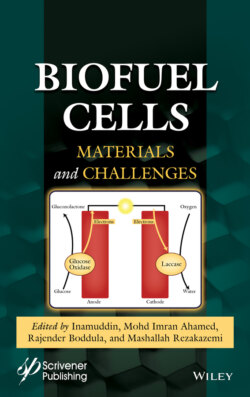Читать книгу Biofuel Cells - Группа авторов - Страница 27
1.6.2 Microbiological Catalysis Control
ОглавлениеThe use of bioelectrodes helps diminishing the overpotential in both, anode and cathode. The reduction of CO2 to CH4 and acetic acid follows metabolic pathways that depend on the cathode potential. Jiang et al. [171] reported that exclusive formation of methane and hydrogen was obtained in the range from −850 to −950 mV, whereas the simultaneous formation of CH4, H2 and acetate occurred in potentials more negatives than −950 mV.
Cathode potentials have been compared by Blanchet et al. [79]. The authors tested −0.36 and −0.66 V/SHE, finding that the former potential was appropriate for CO2 reduction whereas the second potential resulted in hydrogen production in addition to CH4. Thus, acetate was produced in an amount of 244 mg L−1. In the same way, Siegert et al. [172] observed that methane production increased with more negative cathode potential in the order −650 mV > −600 mV > −550 mV. The products recovered were CH4, acetate and some cases formate.
Co-products are expected in MECs, which represent another advantage if they are high value-added metabolites. For instance, acetate has been produced in a membrane-less system at potentials lower than −1.0 V/SHE, but by varying the potential to −0.4 V, the production increased to 600 mg L−1 in 9 days [173]. Similarly, Nie et al. [174] obtained 540 mg L−1 after 8 days, and Marshall et al. [175], using graphite granules at −0.59 V/SHE, produced up to 10,500 mg L−1 over 20 days.
